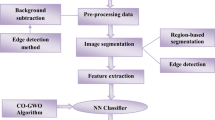Abstract
In order to solve the problems of conventional neural network when it is applied to the diseased plant leaf system such as making itself for better classification, Genetic algorithm-based feed forward neural network (GA_FFNN) hybrid technique is proposed. Besides, Particle swarm optimization (PSO)-based segmented hybrid features were used for the analysis of classification of diseased leaf and its severity. The main contribution of this paper incorporates Genetic weight optimization-based neural network systems of diseased plant leaf classification for better classification accuracy. Various diseased plant leaves such as bitter gourd (Brown Leaf Spot), beans (Pest leaf minor), chilly (Pest), Cotton (Mineral Deficiency), pigeon pea (Blight Leaf minor) and tomato (Leaf spot) were used. In the proposed work, attributes are combined as a single vector for hybrid features. Five attributes, namely contrast, correlation, energy, homogeneity and area of the leaf were used as features. Initially, the features were extracted from the segmented image after preprocessing. Genetic-based Feed Forward Neural network architecture is constructed for the classification of diseased plant leaf. The weight of the neural network is updated by Genetic algorithm for specified iterations. Finally, the performance is analyzed in different classes (class 2, class 3 and class 6) of diseased plant leaves using classification accuracy.




Similar content being viewed by others
References
Abdullah NE, Rahim AA, Hashim H, Kamal MM (2007) Classification of rubber tree leaf diseases using multilayer perceptron neural network. In: SCRD 2007, proceedings of the 5th student conference on Research and Development, pp 1–6
Al-Hiary H, Bani-Ahmad S, Reyalat M, Braik M, ALRahamneh Z (2011) Fast and Accurate Detection and Classification of Plant Diseases. Int J Comput Appl, Wageningen Academic publishers 17:31–38
Beichel R, Sonka M (2006) Computer vision approaches to medical image analysis, vol 4241. Lecture Notes in Computer Science, Springer, Berlin, pp 37–48
Ding SF, Xu L, Su CY, Zhou H (2010) Using genetic algorithm to optimize artificial neural networks. J Converg Inf Technol 5:54–62
Fraser AS (1957) Simulation of genetic systems by automatic digital computers, introduction. Aust J Biol Sci 10:484–491
Horn J, Nafpliotis N, Goldberg DE (1994) A niched pareto genetic algorithm for multiobjective optimization. Evolutionary Computation Paper presented at the IEEE world congress on Computational Intelligence, Orlando, FL, USA, pp 82–87
Hornik KM, Stinchcombe M, White H (1989) Multilayer feed-forward networks are universal approximators. Neural Netw 2:359–366
Kai S, Zhikun L, Hang S, Chunhong G (2011) A research of maize disease image recognition of corn based on BP networks. Third International Conference on Measuring Technology and Mechatronics Automation, Shenyang, China, pp 246–249
Kutty SB, Abdullah NE (2013) Classification of watermelon leaf diseases using neural network analysis. BEIAC, IEEE, pp 459–464
Liu L, Nie F, Zhang T, Wiliem A, Lovell BC (2016) Unsupervised automatic attribute discovery method via multi-graph clustering. ICPR, pp 1713–1718
Liu L, Wiliem A, Chenand S, Lovell BC (2017) What is the best way for extracting meaningful attributes from pictures? Pattern Recogn 64:314–326
Lung Huang C, Jen Wang C (2006) A GA based feature selection and parameters optimization for support vector machines. Expert Syst Appl 31:231–240
Muthukannan K, Latha P (2015) A pso model for disease pattern detection on leaf surfaces. IAS 34:209–216
Revathi P, Hemalatha M (2014) Identification of cotton diseases based on cross information gain deep forward neural network classifier with pso feature selection. Int J Eng Technol 5:4637–4642
Schwefel HP (1995) Evolution and optimum seeking. Wiley, New York
Shi ZZ (2009) Neural networks. Higher Education Press, Beijing
Singh V, Misra AK (2017) Detection of plant leaf diseases using image segmentation and soft computing techniques. Inf Process Agric 4:41–49
Zhang T, Wiliem A, Hemson G, Lovell B (2015) Detecting kangaroos in the wild: the first step towards automated animal surveillance. ICASSP
Acknowledgements
The authors would like to thank the reviewers for their valuable suggestions which have helped in improving the quality of this paper. We would like to thank the Tamilnadu Agricultural University for their continuous encouragement and support.
Author information
Authors and Affiliations
Corresponding author
Rights and permissions
About this article
Cite this article
Muthukannan, K., Latha, P. A GA_FFNN algorithm applied for classification in diseased plant leaf system. Multimed Tools Appl 77, 24387–24403 (2018). https://doi.org/10.1007/s11042-018-5710-5
Received:
Revised:
Accepted:
Published:
Issue Date:
DOI: https://doi.org/10.1007/s11042-018-5710-5




